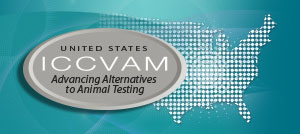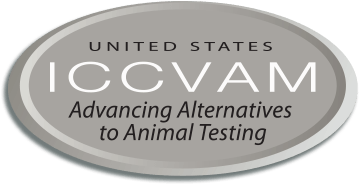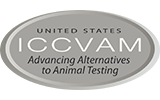The ICCVAM Authorization Act of 2000 (42 U.S.C. 285l-3) established ICCVAM, which is supported by the National Toxicology Program Interagency Center for the Evaluation of Alternative Toxicological Methods (NICEATM). The two groups work collaboratively to evaluate new and improved testing approaches applicable to the needs of U.S. federal agencies. The articles below provide background information on NICEATM and ICCVAM.
About ICCVAM and NICEATM
ICCVAM Establishment and Purpose
U.S. regulatory agencies are charged to protect human and animal health and the environment. To do this, agencies must determine the hazards presented by substances such as pesticides, consumer products, and workplace chemicals. Testing these substances provides information about possible hazards and enables informed decisions about responsible use, storage, and disposal.
Many currently accepted test methods use laboratory animals. Alternative test methods are methods that replace animal use with non-animal test systems or lower species, reduce the number of animals required for a specific test procedure, or refine animal use to enhance animal well-being and lessen or avoid pain and distress. Collectively, the principles of replacement, reduction, or refinement of animal use for scientific research or product safety testing are referred to as the 3Rs. More recently, the term “new approach methodologies” has been adopted as a broadly descriptive reference to any technology, methodology, approach, or combination of these that can be used to provide information on chemical hazard and risk assessment and that support the 3Rs.
The ICCVAM Authorization Act of 2000 (42 U.S.C. 285l-3) established the Interagency Coordinating Committee on the Validation of Alternative Methods (ICCVAM) to
“Establish, wherever feasible, guidelines, recommendations, and regulations that promote the regulatory acceptance of new or revised scientifically valid safety testing methods that protect human and animal health and the environment while reducing, refining, and replacing animal tests and ensuring human safety and product effectiveness.”
The ICCVAM Authorization Act states that the purposes of ICCVAM are to:
- Increase the efficiency and effectiveness of federal agency test method review.
- Eliminate unnecessary duplicative efforts and share experiences between federal regulatory agencies.
- Optimize utilization of scientific expertise outside the federal government.
- Ensure that new and revised test methods are validated to meet the needs of federal agencies.
- Reduce, refine, and replace the use of animals in testing, where feasible.
ICCVAM is a permanent interagency committee of NIEHS under NICEATM.
ICCVAM Member Agencies
- Agency for Toxic Substances and Disease Registry (ATSDR)
- National Cancer Institute (NCI)
- National Institute for Occupational Safety and Health (NIOSH)
- National Institute of Environmental Health Sciences (NIEHS)
- National Institute of Standards and Technology (NIST)
- National Institutes of Health (NIH)
- National Library of Medicine (NLM)
- Occupational Safety and Health Administration (OSHA)
- U.S. Consumer Product Safety Commission (CPSC)
- U.S. Department of Agriculture (USDA)
- U.S. Department of Defense (DoD)
- U.S. Department of Energy (DOE)
- U.S. Department of the Interior (DOI)
- U.S. Department of Transportation (DOT)
- U.S. Department of Veterans Affairs Office of Research and Development (VA ORD)
- U.S. Environmental Protection Agency (EPA)
- U.S. Food and Drug Administration (FDA)
ICCVAM Duties and Activities
The ICCVAM Authorization Act directs ICCVAM to carry out the following duties:
- Coordinate the technical review and evaluation of new, revised, or alternative test methods.
- Foster interagency and international harmonization of test protocols that encourage replacing, reducing, and refining animal test methods.
- Assist with and provide guidance on validation criteria and processes.
- Promote the acceptance of scientifically valid test methods.
- Promote awareness of accepted test methods.
- Submit ICCVAM test method recommendations to appropriate U.S. federal agencies.
- Consider requests from the public to review and evaluate new, revised, or alternative test methods that have evidence of scientific validity.
- Make ICCVAM’s final test recommendations available to the public.
- Prepare reports on ICCVAM progress and accomplishments under the Act and make them available to the public.
ICCVAM Workgroups
ICCVAM establishes ad hoc workgroups to perform specific tasks important for the development or validation of alternatives to animal testing. The workgroups are composed of representatives from agencies that use or require data from the topic of interest. Representatives of partner organizations in the International Cooperation on Alternative Test Methods may also be invited to participate in a workgroup.
ICCVAM workgroups play a key role in carrying out ICCVAM activities, including implementing the goals of the Strategic Roadmap for Establishing New Approaches to Evaluate the Safety of Chemicals and Medical Products in the United States. When a workgroup completes its charge tasks, it transitions to an expert group to facilitate continued communication and engagement in that area of interest.
During 2022-2023, ICCVAM had active workgroups focused on the following areas:
- Acute toxicity: co-chairs Donald Cronce, Ph.D. (DoD) and Grace Patlewicz, Ph.D. (EPA)
- Consideration of alternative methods: co-chairs Jessie Carder (USDA), Matthew Johnson, D.V.M., DACLAM (DoD; through March 2022), and Shannon Marko, D.V.M. (DoD)
- Ecotoxicology: co-chairs William Eckel, Ph.D. (EPA) and Natalia Garcia-Reyero Vinas, Ph.D. (DoD)
- In vitro to in vivo extrapolation: transitioned to expert group status in 2023; co-chairs Moiz Mumtaz, Ph.D. (ATSDR) and Cecilia Tan, Ph.D. (EPA)
- PFAS: co-chairs Natalia Garcia-Reyero Vinas, Ph.D. (DoD), Kelly Carstens, Ph.D. (EPA), and Shruit Kabadi, Ph.D. (FDA)
- Read across: transitioned to expert group status in 2022; chair Grace Patlewicz, Ph.D. (EPA)
- Validation: co-chairs Suzanne Fitzpatrick, Ph.D., D.A.B.T. (FDA), John Gordon, Ph.D. (CPSC), and Elijah Petersen, Ph.D. (NIST)
How NICEATM Supports ICCVAM
NICEATM, an office within the NIEHS Division of Translational Toxicology (DTT), provides technical and scientific support for ICCVAM and ICCVAM workgroup activities, peer review panels, expert panels, workshops, and validation efforts.
In addition to providing support for ICCVAM, NICEATM:
- Supports activities of NIEHS DTT, especially those contributing to the U.S. government’s interagency Tox21 initiative.
- Conducts analyses and evaluations and coordinates independent validation studies on novel and high-priority alternative testing approaches.
- Provides information, data, and tools to test method developers, regulators, and regulated industry through its website and workshops on topics of interest.
NICEATM staff
NIEHS
Nicole Kleinstreuer, Ph.D., Director
Helena Hogberg, Ph.D., Toxicologist
Kamel Mansouri, Ph.D., Computational Chemist
Pei-Li Yao, Ph.D., Health Science Evaluator, Project Officer
NICEATM Contract Staff (Inotiv, Inc.)
David Allen, Ph.D., Principal Investigator
Steven Morefield, M.D., Project Manager
Todd Auman, Ph.D.
Michaela Blaylock
Alexandre Borrel, Ph.D.
Xiaoqing Chang, Ph.D., D.A.B.T.
Amber Daniel, M.S.
Jon Hamm, Ph.D.
Adrian Hardy (subcontractor, Sciome LLC)
Bridgett Hill, M.S.
Victoria Hull, M.S.
Anna Kreutz, Ph.D.
Tripp LaPratt
Eric McAfee (subcontractor, Sciome LLC)
Oluwakemi Oyetade, M.S.
Jason Phillips (subcontractor, Sciome LLC)
Emily Reinke, Ph.D., D.A.B.T.
Catherine Sprankle, M.S.
Getachew Tedla, M.S.
Kimberly To, Ph.D.
Aswani Unnikrishnan, M.S.
ICCVAM Advisory Committee
The ICCVAM Authorization Act established the Scientific Advisory Committee on Alternative Toxicological Methods (SACATM). SACATM advises the Director of NIEHS, NICEATM, and ICCVAM about NICEATM and ICCVAM activities.
SACATM, which is directed by its charter to meet at least once each fiscal year, met in September 2022 and September 2023.
Roster of SACATM Members 2022-2023
| Name | Title | Company | Appointment End Year |
|---|---|---|---|
| Antonio Baines, Ph.D. | Associate Professor, Department of Biological and Biomedical Sciences | North Carolina Central University, Durham, NC | 2025 |
| Szczepan W. Baran, V.M.D., M.S. | Chief Scientific Officer | VeriSIM Life, San Francisco, CA | 2024 |
| Ellen Berg, Ph.D. | Principal | Alto Predict LLC, Palo Alto, CA | 2025 |
| Joseph L. Charest, Ph.D. | Director, Strategic Innovation | Biogen, Cambridge, MA | 2022 |
| Amy Clippinger, Ph.D. | Director | PETA Science Consortium International e.V., Washington, DC | 2022 |
| K. Nadira De Abrew, Ph.D. (Chair 2022) | Senior Scientist (Toxicologist) | The Procter & Gamble Company, Cincinnati, OH | 2022 |
| Denis Fourches, Ph.D. | Computational Chemist | Oerth Bio, Raleigh, NC | 2023 |
| Sean C. Gehen, Ph.D., D.A.B.T. | Human Safety Leader | Corteva Agriscience, Indianapolis, IN | 2022 |
| Sue Leary, M.S. | President | Alternatives Research and Development Foundation, Jenkintown, PA | 2024 |
| Adrian Nañez, Ph.D. | Senior Medical Science Liaison | Servier, Inc., San Antonio, TX | 2025 |
| Kathryn Page, Ph.D., D.A.B.T. (Chair 2023) | Product Safety Toxicologist (Senior Scientist), Global Stewardship | The Clorox Company, Pleasanton, CA | 2024 |
| Priyanka Sura, D.V.M., M.S., D.A.B.T. | Senior Occupational Toxicologist, Nonclinical Safety and Pathobiology | Gilead Sciences, Inc., Foster City, CA | 2024 |
| Tamara Tal, Ph.D. | Senior Scientist, Group Leader | Helmholtz Center for Environmental Research – UFZ, Leipzig, Germany | 2023 |
| Misti Ushio, Ph.D. | Managing Partner | Digitalis Ventures, New York, NY | 2024 |



